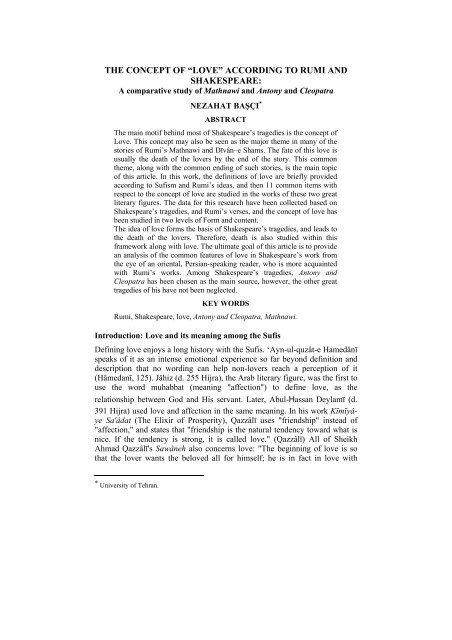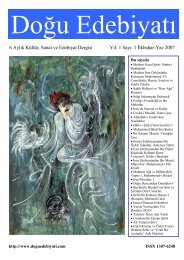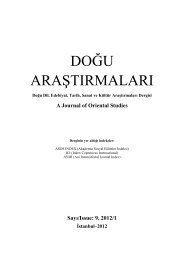A Journal of Oriental Studies Sayı/Issue - Doğu Edebiyatı
A Journal of Oriental Studies Sayı/Issue - Doğu Edebiyatı
A Journal of Oriental Studies Sayı/Issue - Doğu Edebiyatı
Create successful ePaper yourself
Turn your PDF publications into a flip-book with our unique Google optimized e-Paper software.
THE CONCEPT OF “LOVE” ACCORDING TO RUMI AND<br />
SHAKESPEARE:<br />
A comparative study <strong>of</strong> Mathnawi and Antony and Cleopatra<br />
NEZAHAT BAŞÇI *<br />
ABSTRACT<br />
The main motif behind most <strong>of</strong> Shakespeare’s tragedies is the concept <strong>of</strong><br />
Love. This concept may also be seen as the major theme in many <strong>of</strong> the<br />
stories <strong>of</strong> Rumi’s Mathnawi and Dīvân–e Shams. The fate <strong>of</strong> this love is<br />
usually the death <strong>of</strong> the lovers by the end <strong>of</strong> the story. This common<br />
theme, along with the common ending <strong>of</strong> such stories, is the main topic<br />
<strong>of</strong> this article. In this work, the definitions <strong>of</strong> love are briefly provided<br />
according to Sufism and Rumi’s ideas, and then 11 common items with<br />
respect to the concept <strong>of</strong> love are studied in the works <strong>of</strong> these two great<br />
literary figures. The data for this research have been collected based on<br />
Shakespeare’s tragedies, and Rumi’s verses, and the concept <strong>of</strong> love has<br />
been studied in two levels <strong>of</strong> Form and content.<br />
The idea <strong>of</strong> love forms the basis <strong>of</strong> Shakespeare’s tragedies, and leads to<br />
the death <strong>of</strong> the lovers. Therefore, death is also studied within this<br />
framework along with love. The ultimate goal <strong>of</strong> this article is to provide<br />
an analysis <strong>of</strong> the common features <strong>of</strong> love in Shakespeare’s work from<br />
the eye <strong>of</strong> an oriental, Persian-speaking reader, who is more acquainted<br />
with Rumi’s works. Among Shakespeare’s tragedies, Antony and<br />
Cleopatra has been chosen as the main source, however, the other great<br />
tragedies <strong>of</strong> his have not been neglected.<br />
KEY WORDS<br />
Rumi, Shakespeare, love, Antony and Cleopatra, Mathnawi.<br />
Introduction: Love and its meaning among the Sufis<br />
Defining love enjoys a long history with the Sufis. ‘Ayn-ul-quzât-e Hamedânī<br />
speaks <strong>of</strong> it as an intense emotional experience so far beyond definition and<br />
description that no wording can help non-lovers reach a perception <strong>of</strong> it<br />
(Hâmedanī, 125). Jâhiz (d. 255 Hijra), the Arab literary figure, was the first to<br />
use the word muhabbat (meaning "affection") to define love, as the<br />
relationship between God and His servant. Later, Abul-Hassan Deylamī (d.<br />
391 Hijra) used love and affection in the same meaning. In his work Kīmīyâye<br />
Sa'âdat (The Elixir <strong>of</strong> Prosperity), Qazzâlī uses "friendship" instead <strong>of</strong><br />
"affection," and states that "friendship is the natural tendency toward what is<br />
nice. If the tendency is strong, it is called love." (Qazzâlī) All <strong>of</strong> Sheikh<br />
Ahmad Qazzâlī's Sawâneh also concerns love: "The beginning <strong>of</strong> love is so<br />
that the lover wants the beloved all for himself; he is in fact in love with<br />
* University <strong>of</strong> Tehran.





